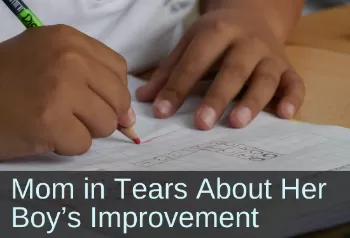Primitive Reflex Integration Case Studies
Skeptical OT Convinced by “Profound Success” in Short Time Frame
Neurodevelopmental movements help with attention, fine motor skills, and visual processing.
Here is an example of how a skeptical OT helped her 8-year-old client. This little boy struggled for years with poor handwriting and difficulty attending to structured tasks, but saw profound improvements through neurodevelopmental movements in just 5 sessions.
Submitted by Jessica Rilee, OTD, OTR/L

| Before | After |
|---|---|
| Struggled for years with poor handwriting, despite trying many traditional strategies such as special pencil grips and chair cushions. | Experienced remarkable improvement in confidence and fluidity during handwriting tasks; achieved "above average legibility" on a handwriting assignment. |
| On a vision performance screen, visual tracking was equivalent to a 5-year-old, an approximate 3-year delay. | On a vision performance screen, this 8-year-old performed at the speed and accuracy of a 10-year-old |
Tommy is an 8-year-old boy who has struggled for years with poor handwriting and difficulty attending to structured tasks. In the classroom and at home, he tried all different pencil grips and chair cushions to improve his performance, but his parents report that the effects of these strategies wear off after a short period of time. Although he was not formally diagnosed, parents labeled and attributed his behavior and school performance as an indication of attention-deficit disorder, and Tommy’s pediatrician had recommended further screening and assessment to determine if medication should be their next step.
When Tommy was evaluated by an occupational therapist, Tommy is observed to have significant difficulty maintaining an upright posture, slouching into his seat at the table. His handwriting was described as having poor spacing, baseline orientation, and letter formation when copying a sentence, and inadequate ability to visually attend and maintain his place on the page. During a vision performance screen, Tommy’s visual tracking is equivalent to a 5-year-old, an approximate 3-year delay.
Starting with the 5-step balance process, [from the Brain and Sensory Foundations course] Tommy’s goal is to improve his handwriting for his parents and teachers so that he “doesn’t have to read it to them all the time.” Tommy is active and enjoys games with lots of movement, so I chose to use several reflex integration activities in combination with creative play over obstacle courses and games, which also incorporate developmental movements patterns. The reflex integration activities [from the Brain and Sensory Foundations course] with the most focus during treatments were selected based on Tommy’s reactions to reflex stimulation and clinical observations of his movement and behaviors, primarily symmetrical and asymmetrical tonic neck reflex, and tonic labyrinthine reflex.
At first, Tommy’s performance began to improve briefly during sessions when we compared his handwriting before and after treatments. A couple of weeks later, it became more obvious that Tommy was putting in less effort and demonstrating an improvement through coordination and attention during activities and movement games. After five sessions of focused integration using the five-step balance process, Tommy’s mom entered the clinic in tears with a handwriting assignment from his teacher where he had written with above average legibility. Tommy has continued to maintain, if not even improve, his handwriting ever since.
Although we continue to work on some of the same integration and playful movement activities [from the Brain and Sensory Foundations course] during treatment sessions, Tommy’s confidence and fluidity during handwriting tasks is remarkable. On a follow-up visual screening, Tommy can perform at the speed and accuracy of a 10-year-old, he’s still just 8 years old!
At first, I was skeptical about this treatment process, thinking how it could work differently because there were already lots of similarities to what I was doing with clients. However, I learned quickly that there is an important scientific and clinically based process that results in such successful outcomes. I may have accomplished the same goals with Tommy, but I would not have been able to do it in a precise and focused way that benefited with such profound success, especially in this short amount of time.
[Edited for length and clarity, emphasis added]
*Disclaimer: The activities in the Brain and Sensory Foundations curriculum make use of the natural processes of neuroplasticity and development that are innately wired in the design of human beings to promote maturity and function. These activities appear to calm, organize, and mature the neuro-sensory-motor systems just as we see in the healthy development of human infants. Individual results may vary, and we do not claim to offer a diagnosis or cure for any specific condition or disorder. The Brain and Sensory Foundations activities appear to improve overall functioning resulting in measurable improvements for a range of conditions as demonstrated in over 1800 case studies from participants.

